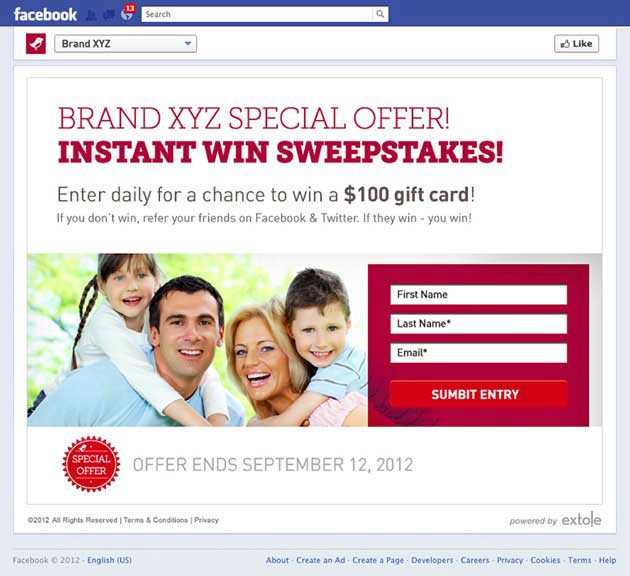The past decade has included a massive surge of improvements and advancements to the way consumers carry on their digital lives.
Here we are in 2012, everyone is connected, and everyone is sharing more and more online every day. Social networking sites reach 82% of the world's online population—that's 1.2 billion users worldwide!
Consumers have now become a brand's most influential stakeholder, wielding the ability to influence friends and peers significantly more than advertisers can. That shift in power has caused a corresponding transformation in social networks and how brands use them to engage with and market to consumers.
Facebook's Open Graph, for one, is a formidable force that is changing the way brands and consumers interact. As 2013 approaches, more brands will try to quantify the ROI of their Facebook marketing investments, and the Open Graph provides significant new marketing opportunities to do just that.
Brands can engage with consumers both on and off Facebook, broadcast consumer stories across Facebook, and drive awareness and word-of-mouth (WOM). Brands can also buy Facebook Sponsored Stories to improve the performance of their advertising on Facebook and test the convergence of media types.
Let's take a look at the five ways that Facebook's Open Graph will have an impact marketing and how a particular children's retailer used the Open Graph to drive massive brand awareness and engagement.
1. Moving Beyond the 'Like'
With Facebook's Open Graph, brands can now create relationships and interactions with consumers that are contextually relevant. For example, a wine distributor can enable users to "recommend" or "taste" a wine, a fashion brand can allow users to "want" a pair of shoes or "own" a dress.
The Open Graph enables brands to interact with consumers across all touchpoints (website, ecommerce storefront, and more) to create those contextually relevant stories, which are then broadcast via Facebook to the consumer's Timeline as well as their friends' News Feeds and Tickers. All of those stories create powerful, relevant earned media that allows brands to drive awareness and WOM.
Savvy brands will develop a strategy to use Open Graph actions that are aligned with their brand, products, and services. They will use Open Graph applications to create opportunities for contextually relevant engagement and sharing with consumers, both on and off of Facebook.
2. Shifting the Facebook Focus to the Consumer Timeline
While the Brand Timeline is an important tool for consumer engagement, Consumer Timelines are where the majority of interaction takes place, making them incredibly valuable to marketers.
Consumer stories about brands are now broadcast front-and-center on the Consumer Timelines as well as in the News Feeds and Tickers of their friends, creating digital virality. In addition, brands can create a persistent connection with consumers' Timelines by creating an aggregation or "Brand Billboard" that tells the ongoing story of that relationship.
Brands need to develop strategies to claim real estate on the Consumer Timeline, and they need programs to foster consumer stories via the Open Graph.
3. Gaining Unprecedented Insight Into Consumer Demographics
With Facebook, marketers can understand who is sharing stories about their brand, as well as reach (impressions), engagement (clicks), and conversions. Marketers can also see aggregate demographics of friends who engage with stories, enabling them to optimize campaigns. For example, marketers could see that females dramatically outperform males on a campaign and so reallocate ad budget accordingly.
The deep insights through the Open Graph will enable brands to optimize marketing campaigns both on an off Facebook.
4. Replacing Facebook Ads with Sponsored Stories
Sponsored Stories is significantly more relevant than most advertising, because friends are endorsing brands and providing social context. Facebook research shows that recall of messages increases 50% with social context. Sponsored Stories results are significantly higher, with a 46% higher CTR and a 20% lower CPC than Facebook Ads. In Addition, Sponsored Stories are the only mobile ad unit on Facebook.
If Sponsored Stories plays out according to Facebook's plan, more and more brands will switch their Facebook ad dollars to Sponsored Stories.
5. Facilitating the Convergence of Owned, Earned, and Paid Media
With the Open Graph, brands can engage consumers across all owned media touchpoints (website, blogs, social networks, and more) and foster creation of earned media (Stories). That earned media is then broadcast across Facebook to amplify awareness organically. Brands can further amplify the reach of earned media storiesby purchasing highly effective paid media (Sponsored Stories). Or, in Facebook's words, spread word-of-mouth at scale.
With Facebook, brands will be able to implement strategies to test the impact of the convergence of media types. Brands will be able to foster earned media (in the form of consumer stories) to fuel more effective paid media (Sponsored Stories).
An Example
Highlighting those five impacts, Extole (my company) recently powered a Facebook social promotion for a leading children's retailer.
The promotion was a Back to School Instant Win Sweepstakes with a goal of generating 10,000 participants.

The children's retailer combined owned, earned, and paid media to garner participation in the sweepstakes and generated 14 million impressions and 27,641 unique entries, and each entrant participated an average of 3.9 times.
Owned media brand promotion drove 22% of the sweepstake entries. Earned media from the organic Open Graph stories and direct referrals drove 69% of the sweepstakes entries. Paid media Sponsored Stories drove an additional 9% of the entries with only $5,500 in ad spend.
For every person who entered the sweepstakes after seeing a promotional message from the brand, at least three more people participated based on earned media recommendations.
What's even more impactful is that the brand promotions hit only the brand's fans and customer list. The earned media stories and Sponsored Stories hit an audience of nearly 4.8 million friends on Facebook—13 times the audience of brand promotions!
* * *
Facebook's Open Graph allows brands to quantify the ROI of their social investments, drive advocacy, awareness, and engagement, and it provides a canvas for brands to test the impact of the convergence of media types today.
The next generation of social marketing is here, and Facebook's Open Graph is leading the charge.




